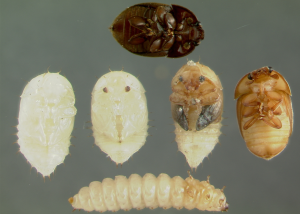Members of the UF/IFAS Honey Bee Research and Extension Laboratory conducted a research project that led to a publication on small hive beetles and their ability to transmit honey bee pathogens. Below is a summary of the research as well as a link to the full publication.
Background
Small hive beetles (SHBs) are an invasive pest of western honey bee (Apis mellifera) colonies. They invade hives and use colony resources (honey/pollen/brood) to reproduce, ultimately leading to hive loss in certain circumstances. Recently, scientists have questioned SHB ability to transmit honey bee pathogens, given that some pathogens have been associated with SHBs. In this regard, some pathogens were of particular interest to our team.
Lotmaria passim and Crithidia mellificae are microorganisms that can colonize the honey bee gut. This happens through fecal and oral transmission between honey bees. These parasites can affect the honey bee’s general health.
Deformed wing virus (DWV) is a RNA virus that impacts the development of honey bee wings and shortens honey bee lifespans. DWV is transmitted by Varroa destructor, a parasitic mite that feeds on honey bee fat bodies. Kashmir bee virus (KBV), another RNA virus, can also lead to bee death.
Paenibacillus larvae is the bacterium that causes American foulbrood while Melissococcus plutonius is the bacterium that causes European foulbrood. Both diseases kill developing honey bees.

Purpose
The purpose of this experiment was to screen for the presence of bacteria (P. larvae or M. plutonius), trypanosomatids (L. passim and C. mellificae), and viruses (DWV and KBV) in/on SHBs. This is the first step in determining if SHBs can spread these pathogens between colonies.
Key Findings
The SHBs were found to have C. mellificae, L. passim, KBV, and DWV. No SHBs were found to be associated with P. larvae or M. plutonius.
Significance
The results from this study suggest that pathogen spillover between managed honey bees and SHBs is possible. Furthermore, SHBs may move honey bee pathogens between colonies, though this idea needs to be confirmed experimentally.
For more details, read the publication here: https://doi.org/10.3390/pathogens10030372
This blog post was written by UF IFAS Honey Bee Lab volunteer Julia Volpi and revised by Amy Vu and Dr. Jamie Ellis
Nanetti, A., Ellis, J.D., Cardaio, I., Cilia, G. 2021. Detection of Lotmaria passim, Crithidia mellificae and replicative forms of Deformed Wing Virus and Kashmir Bee Virus in the small hive beetle (Aethina tumida). Pathogens, 10, 372. https://doi.org/10.3390/pathogens10030372.
 0
0
